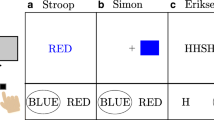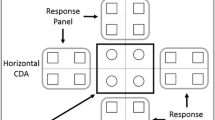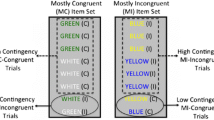Abstract
According to a central claim of Kornblum's dimensional-overlap model, response-related processes do not start before stimulus-related processes have been completed, which implies an additive relationship between effects of stimulus-stimulus congruence and stimulus-response compatibility. Three experiments were conducted to test this prediction. In Exp. 1, additive effects of color-word congruence (Stroop effect) and irrelevant spatial S-R compatibility (Simon effect) were in fact obtained. However, interactions between congruence and compatibility were observed in Exp. 2, where flanker-target congruence was varied, and in Exp. 3, where inter-level congruence of multi-level letters was manipulated. It is argued that these findings are inconsistent with the seriality assumption of the dimensional-overlap model, but that they support models claiming a temporal overlap of stimulus and response processing instead.
Similar content being viewed by others
References
Bekkering, H. (1995). Eye-hand coordination: Cooperative and competitive systems? Den Haag: Koninklijke Bibliotheek.
Boer, L. C., Keuss, P. J. G. (1982). Global precedence as a postperceptual effect: An analysis of speed-accuracy tradeoff functions. Perception & Psychophysics, 31, 358–366.
Coles, M. G. H., Gratton, G., Bashore, T. R., Eriksen, C. W., & Donchin, E. (1985). A psychophysiological investigation of the continuous flow model of human information processing. Journal of Experimental Psychology: Human Perception and Performance, 11, 529–553.
De Jong, R., Liang, C. C., & Lauber, E. (1994). Conditional and unconditional automaticity: A dual-process model of effects of spatial stimulus-response correspondence. Journal of Experimental Psychology: Human Perception and Performance, 20, 731–750.
Deubel, H., & Schneider, W. X. (1996). Saccade target selection and object recognition: Evidence for a common attentional mechanism. Vision Research, 36, 1827–1837.
Duncan-Johnson, C. C., & Kopell, B. S. (1981). The Stroop effect: Brain potentials localize the source of interference. Science, 214, 938–940.
Eimer, M. (1995). Stimulus-response compatibility and automatic response activation: Evidence from psychophysiological studies. Journal of Experimental Psychology: Human Perception and Performance, 21, 837–854.
Eimer, M., Hommel, B., & Prinz, W. (1995). S-R compatibility and response selection. Acta Psychologica, 90, 301–313.
Eriksen, B. A., & Eriksen, C. W. (1974). Effects of noise letters upon the identification of a target letter in a nonsearch task. Perception & Psychophysics, 16, 143–149.
Eriksen, C. W., Coles, M. G. H., Morris, L. R., & O'Hara, W. P. (1985). An electromyographic examination of response competition. Bulletin of the Psychonomic Society, 23, 165–168.
Fitts, P. M., & Seeger, C. M. (1953). S-R compatibility: Spatial characteristics of stimulus and response codes. Journal of Experimental Psychology, 46, 199–210.
Grice, G. R., & Gwynne, J. W. (1985). Temporal characteristics of noise conditions producing facilitation and interference. Perception & Psychophysics, 37, 495–501.
Grice, G. R., Boroughs, J. M., & Canham, L. (1984). Temporal dynamics of associative interference and facilitation produced by visual context. Perception & Psychophysics, 36, 499–507.
Grice, G. R., Canham, L., & Boroughs, J. M. (1983). Forest before trees? It depends where you look. Perception & Psychophysics, 33, 121–128.
Harms, L., & Bundesen, C. (1983). Color segregation and selective attention in a nonsearch task. Perception & Psychophysics, 33, 11–19.
Hasbroucq, T., & Guiard, Y. (1991). Stimulus-response compatibility and the Simon effect: Toward a conceptual clarification. Journal of Experimental Psychology: Human Perception and Performance, 17, 246–266.
Hell, W. (1987). Aufmerksamkeit und Interferenz. Weinheim: Beltz.
Hommel, B. (1993). The relationship between stimulus processing and response selection in the Simon task: Evidence for a temporaloverlap. Psychological Research/Psychologische Forschung, 55, 280–290.
Hommel, B. (1994a). Spontaneous decay of response code activation. Psychological Research/Psychologische Forschung, 56, 261–268.
Hommel, B. (1994b). Effects of irrelevant spatial S-R compatibility depend on stimulus complexity. Psychological Research/Psychologische Forschung, 56, 179–184.
Hommel, B. (1995a). Conflict versus misguided search as explanation of S-R correspondence effects. Acta Psychologica, 89, 37–51.
Hommel, B. (1995b). Attentional scanning in the selection of central targets from multi-symbol strings. Visual Cognition, 2, 119–144.
Hommel, B. (1996). Decay and maintenance of spatial codes under dual-task conditions. Manuscript submitted for publication.
Hommel, B. (in press). Toward an action-concept model of stimulus-response compatibility. In B. Hommel & W. Prinz (Eds.), Theoretical issues in stimulus-response compatibility. Amsterdam: North-Holland.
Kornblum, S. (1992). Dimensional overlap and dimensional relevance in stimulus-response and stimulus-stimulus compatibility. In G. E. Stelmach, & J. Requin (Eds.), Tutorials in motor behavior (Vol. 2, pp. 743–777). Amsterdam: North-Holland.
Kornblum, S. (1994). The way irrelevant dimensions are processed depends on what they overlap with: The case of Stroop- and Simon-like stimuli. Psychological Research/Psychologische Forschung, 56, 130–135.
Kornblum, S., Hasbroucq, T., & Osman, A. (1990). Dimensional overlap: Cognitive basis for stimulus-response compatibility — a model and taxonomy. Psychological Review, 97, 253–270.
Lu, C.-H. (in press). Correspondence effects for irrelevant information in choice-reaction tasks: Characterizing the S-R relations and the processing dynamics. In B. Hommel & W. Prinz (Eds.), Theoretical issues in stimulus-response compatibility. Amsterdam: North-Holland.
MacLeod, C. M. (1991). Half a century of research on the Stroop effect: An integrative review. Psychological Bulletin, 109, 163–203.
Miller, J. (1981). Global precedence in attention and decision. Journal of Experimental Psychology: Human Perception and Performance, 7, 1161–1174.
Miller, J. (1988). Discrete and continuous models of human information processing: Theoretical distinctions and empirical results. Acta Psychologica, 67, 191–257.
Miller, J. (1991). The flanker compatibility effect as a function of visual angle, attentional focus, visual transients, and perceptual load: A search for boundary conditions. Perception & Psychophysics, 49, 270–288.
Navon, D. (1977). Forest before trees: The precedence of global features in visual perception. Cognitive Psychology, 9, 353–383.
Ratcliff, R. (1979). Group reaction time distributions and an analysis of distribution statistics. Psychological Bulletin, 86, 446–461.
Ridderinkhof, K. R. (1993). Interference from irrelevant information: Models, methods, and developmental trends. Amsterdam: Universiteit van Amsterdam.
Ridderinkhof, K. R., & Van der Molen, M. W. (1995). When global information and local information collide: A brain potential analysis of the locus of interference effects. Biological Psychology, 41, 29–53.
Sanders, A. F. (1980). Stage analysis of reaction processes. In G. E. Stelmach & J. Requin (Eds.), Tutorials in motor behavior (pp. 331–354). Amsterdam: North-Holland.
Simon, J. R., & Berbaum, K. (1990). Effect of conflicting cues on information processing: The “Stroop effect” vs. the “Simon effect”. Acta Psychologica, 73, 159–170.
Simon, J. R., & Small, A. M., Jr. (1969). Processing auditory information: Interference from an irrelevant cue. Journal of Applied Psychology, 53, 433–435.
Simon, J. R., Acosta, E., Mewaldt, S. P., & Speidel, C. R. (1976). The effect of an irrelevant directional cue on choice reaction time: Duration of the phenomenon and its relation to stages of processing. Perception & Psychophysics, 19, 16–22.
Simon, J. R., Paullin, C., Overmyer, S. P., & Berbaum, K. (1985). Reaction time to word meaning and ink color of laterally-presented Stroop stimuli: Effects of handedness and sex. International Journal of Neuroscience, 28, 21–33.
Smid, H. G. O. M., Lamain, W., Hogeboom, M. M., Mulder, G., & Mulder, L. J. M. (1991). Psychophysiological evidence for continuous information transmission between visual search and response processes. Journal of Experimental Psychology: Human Perception and Performance, 17, 696–714.
Smid, H. G. O. M., Mulder, G., & Mulder, L. J. M. (1990). Selective response activation can begin before stimulus recognition is complete: A psychophysiological and error analysis of continuous flow. Acta Psychologica, 74, 169–201.
Sommer, W., Leuthold, H., & Hermanutz, M. (1993). Covert effects of alcohol revealed by event-related potentials. Perception & Psychophysics, 54, 127–135.
Sternberg, S. (1969). The discovery of processing stages: Extensions of Donders' method. Acta Psychologica, 30, 276–315.
Stoffels, E.-J., & Van der Molen, M. W. (1988). Effects of visual and auditory noise on visual choice reaction time in a continuousflow paradigm. Perception & Psychophysics, 44, 7–14.
Stoffer, T. H. (1994). Attentional zooming and the global-dominance phenomenon: Effects of level-specific cuing and abrupt visual onset. Psychological Research/Psychologische Forschung, 56, 83–98.
Stroop, J. R. (1935). Studies of interference in serial verbal reactions. Journal of Experimental Psychology, 28, 643–662.
Sugg, M. J., & McDonald, J. E. (1994). Time course of inhibition in color-response and word-response versions of the Stroop task. Journal of Experimental Psychology: Human Perception and Performance, 20, 647–675.
Van der Heijden, A. H. C. (1981). Short-term visual information forgetting. London: Routledge & Kegan Paul.
Zachay, A. (1991). Diskrete und kontinuierliche Informationsverarbeitungsmodelle zur Erklärung von Reiz-Reaktions-Inkompatibilitäten: Evidenz für einen Antwortkonflikt beim Simon Effekt. Unpublished master's thesis, University of Tübingen, Tübingen, Germany.
Author information
Authors and Affiliations
Rights and permissions
About this article
Cite this article
Hommel, B. Interactions between stimulus-stimulus congruence and stimulus-response compatibility. Psychol. Res 59, 248–260 (1997). https://doi.org/10.1007/BF00439302
Received:
Accepted:
Issue Date:
DOI: https://doi.org/10.1007/BF00439302




